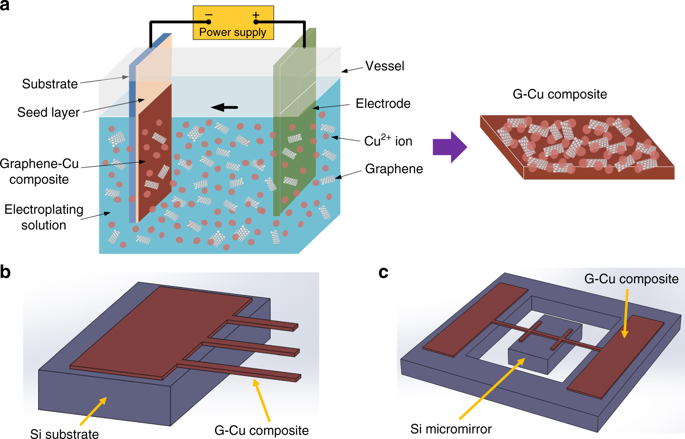Microsystems & Nanoengineering ( IF 7.9 ) Pub Date : 2019-05-20 , DOI: 10.1038/s41378-019-0059-0 Zhonglie An 1, 2 , Jinhua Li 1 , Akio Kikuchi 1 , Zhuqing Wang 3 , Yonggang Jiang 4 , Takahito Ono 1

|
High-density integration technologies with copper (Cu) through-silicon via (TSV) have emerged as viable alternatives for achieving the requisite integration densities for the portable electronics and micro-electro-mechanical systems (MEMSs) package. However, significant thermo-mechanical stresses can be introduced in integrated structures during the manufacturing process due to mismatches of thermal expansion and the mechanical properties between Cu and silicon (Si). The high-density integration demands an interconnection material with a strong mechanical strength and small thermal expansion mismatch. In this study, a novel electroplating method is developed for the synthesis of a graphene-copper (G-Cu) composite with electrochemically exfoliated graphenes. The fabrication and evaluation of the G-Cu composite microstructures, including the microcantilevers and micromirrors supported by the composite, are reported. We evaluated not only the micromechanical properties of the G-Cu composite based on in-situ mechanical resonant frequency measurements using a laser Doppler vibrometer but also the coefficients of thermal expansion (CTE) of the composite based on curvature radius measurements at a temperature range of 20–200 °C. The Young’s modulus and shear modulus of the composite are approximately 123 and 51 GPa, which are 1.25 times greater and 1.22 times greater, respectively, than those of pure Cu due to the reinforcement of graphene. The G-Cu composite exhibits a 23% lower CTE than Cu without sacrificing electrical conductivity. These results show that the mechanically strengthened G-Cu composite with reduced thermal expansion is an ideal and reliable interconnection material instead of Cu for complex integration structures.
中文翻译:

机械强化的石墨烯-Cu 复合材料,在互连应用中具有降低的热膨胀
使用铜 (Cu) 硅通孔 (TSV) 的高密度集成技术已成为实现便携式电子和微机电系统 (MEMS) 封装所需集成密度的可行替代方案。然而,由于铜和硅 (Si) 之间的热膨胀和机械性能不匹配,在制造过程中会在集成结构中引入显着的热机械应力。高密度集成需要具有强机械强度和小热膨胀失配的互连材料。在这项研究中,开发了一种新的电镀方法,用于合成具有电化学剥离石墨烯的石墨烯-铜 (G-Cu) 复合材料。G-Cu复合材料微结构的制备和评价,包括由复合材料支撑的微悬臂梁和微镜。我们不仅基于使用激光多普勒测振仪进行的原位机械共振频率测量来评估 G-Cu 复合材料的微机械性能,而且还基于曲率半径测量在20–200 °C。由于石墨烯的增强,复合材料的杨氏模量和剪切模量约为 123 和 51 GPa,分别是纯铜的 1.25 倍和 1.22 倍。在不牺牲导电性的情况下,G-Cu 复合材料的 CTE 比 Cu 低 23%。



























 京公网安备 11010802027423号
京公网安备 11010802027423号